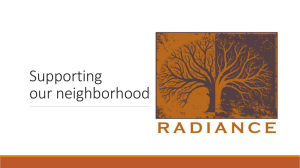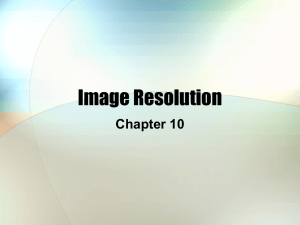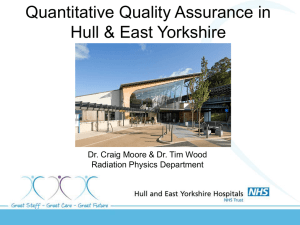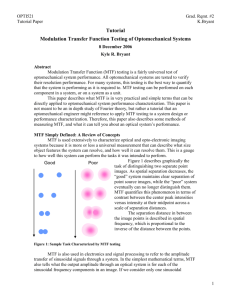Digital Imagery Spatial Resolution and Radiometry by Mary
advertisement
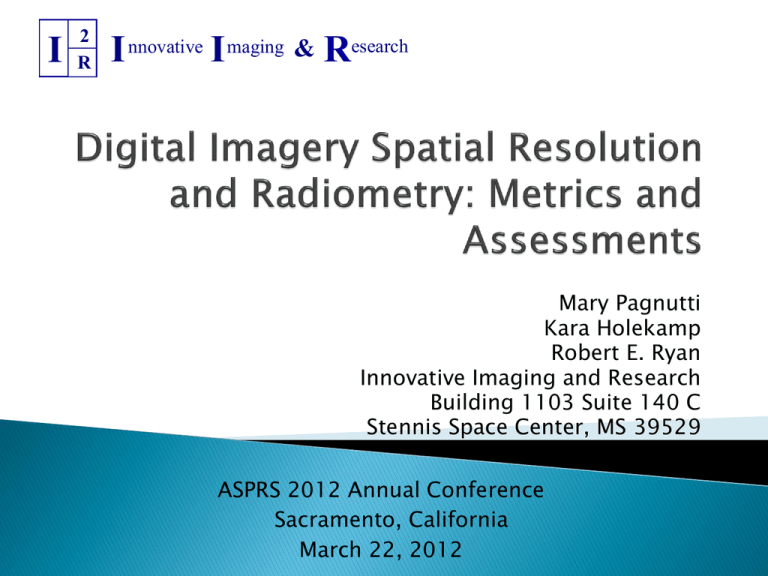
I 2 R I nnovative I maging & Research Mary Pagnutti Kara Holekamp Robert E. Ryan Innovative Imaging and Research Building 1103 Suite 140 C Stennis Space Center, MS 39529 ASPRS 2012 Annual Conference Sacramento, California March 22, 2012 Mapping and remote sensing systems are becoming indistinguishable High spatial resolution satellites are designed and specified to do both 2 Aerial and satellite digital imaging systems are very similar with the following exceptions ◦ Differ in the amount of atmosphere and collection geometries ◦ Typically not as extensively characterized Radiometry and spatial resolution specifications not emphasized Spatial resolutions depends on altitude (satellites altitudes are typically fixed) Both radiometry and spatial resolution are not simple to validate (Part of the reason limited specification) 3 Aerial and satellite digital imaging systems are very similar with the following exceptions ◦ Differ in the amount of atmosphere and collection geometries ◦ Typically not as extensively characterized Radiometry and spatial resolution specifications not emphasized Spatial resolutions depends on altitude (satellites altitudes are fixed) Both are not the simple to validate (Part of the reason limited specification) 4 Depends on: ◦ Pixel size, measured by: Ground Sample Distance (GSD) ◦ Point Spread Function (PSF) - the response that an electro-optical system has to a point source The sharper the function, the sharper the object will appear in the system output image Difficult to directly measure 1 ◦ Flight operations/installation 0.8 0.6 0.4 Values are determined in a laboratory and then validated in flight 0.2 0 4 2 4 2 0 0 -2 Y 6 -2 -4 -4 X Spatial Domain Relative Edge Response (RER) Ringing Overshoot Frequency Domain Modulation Transfer Function (MTF) ◦ MTF at Nyquist typical parameter 1.0 1.0 MTF Region where mean slope is estimated MTF @ Nyquist 0 Ringing Undershoot -2.0 -1.0 0.0 Pixels 1.0 2.0 Spatial frequency Cut-off frequency 7 MTF is a parameter described in the spatial frequency domain ◦ Mathematically allows you to model the imaging process by multiplication instead of convolution ◦ Not physically intuitive ◦ Evaluated in two separate orthogonal directions consistent with the along track and cross track of the image MTF is defined as the magnitude of the OTF (Optical Transfer Function) ◦ OTF is defined as the Fourier Transform of the PSF OTF (u, v) PSF( x, y) exp[i 2 (u v)]dxdy MTF (u ) OTF (u ) OTF (0) 8 Predicts NIIRS as a function of scale, imagery sharpness, contrast, SNR and image enhancement Used to predict performance apriori ◦ Design of systems ◦ Insight on processing NIIRS = 10.251 – a log10 GSDGM + b log10 RERGM – 0.656 HGM – 0.344*G/SNR Where: GSDGM is the geometric mean of the ground sampled distance RERGM is the geometric mean of the normalized edge response HGM is the geometric mean-height overshoot caused by MTFC G is the noise gain associated with MTFC. If the RER >0.9, a=0.32 and b =0.559; otherwise, a=3.16 and b=2.817 9 Line Spread Funcation DN 500 -15 -10 -5 0 5 Distance / GSD 10 15 • Measured edge response along “tilted edge” FWHM 0 -5 -4 -3 -2 -1 0 1 2 3 4 5 • Derivative of edge response or line spread function 1 • Fourier transform of line spread function or MTF • Nyquist frequency is 0.5 * sampling frequency or (1/(2GSD)) 0.5 Distance / GSD MTF 1000 Measured point Best fit 1 Nyquist frequency 0.5 MTF @ Nyquist frequency 0 0 0.5 Normalized spatial frequency 1 10 MTF and RER can be related to each other through Fourier analysis 11 (Constant MTF = 0.7) GSD = 1.5 in/4 cm GSD = 6 in/15 cm GSD = 1 ft/30 cm GSD = 2 ft/60 cm 12 (Constant GSD = 16 cm/~6 in) MTF = 0.05 MTF = 0.4 MTF = 0.7 13 (Constant GSD = 30 cm/~12 in) MTF = 0.05 MTF = 0.4 MTF = 0.7 14 DN 3 examples of undersampled edge responses measured across the tilted edge x – edge tilt angle – pixel index Pixels – pixel’s distance from edge (in GSD) Solution: Image tilted edge to improve sampling DN Problem: Digital cameras undersample edge target Superposition of 24 edge responses shifted to compensate for the tilt March 8, 2006 Distance/GSD 15 These types of targets however, will not generally be available in the imagery to validate spatial resolution Deployable targets at South Dakota State University Pong Hu, Taiwan Fort Huachuka tri-bar target Finnish Geodetic Institute Sjökulla Site Causeway bridge over Lake Pontchartrain Digital Globe provided satellite imagery 16 Most commonly used spatial resolution estimation techniques require engineered targets (deployed or fixed), which are not always available or convenient Target size scales with GSD ◦ Edge targets are typically uniform edges 10-20 pixels long and ~10 pixels tilted a few degrees relative to pixel grid (improve sampling) ◦ Increasing GSD increases difficulty Moderate resolution systems such as Landsat use pulse targets 17 Exploit edge features in nominal imagery ◦ Edge response estimation is performed without dedicated engineered targets Appropriate for high spatial resolution Imagery Automated processes exist that can ◦ Identify edges and screen them ◦ Construct resulting edge response ◦ Calculate MTF and RER Rooflines Building Shadows 18 IKONOS Imagery SNR ~ 100 IKONOS Imagery with noise added SNR ~ 2 Includes material © Space Imaging LLC 20 Digital Number (DN) functional relationship with brightness (radiance), aperture and integration time (Linearity/Dynamic Range) Quantization (Typical for Aerial Data Spec) Pixel-to-pixel (image normalization or flat fielding) Band-to-band (spectrum) (Colorimetry) Typical remote sensing industry goal <1% 22 Absolute Radiometry ◦ Conversion of DN to engineering units of radiance (remote sensing) ◦ Typical remote sensing goal is <5% difference from a National Standard (Landsat Data Continuity Mission (LDCM) Data Specification, March 2000) Colorimetry ◦ Ability to produce true colors from sensor intrinsic RGB In general if a system has good relative radiometry then good color balancing can be achieved. Similarly systems that have good absolute radiometry have good color balance 23 Integrating Sphere In-band Radiance Calibration Integration Time Maximum Reference DN Calibration F# Using the spectral response and integrating sphere radiance both normalization and absolute calibration can be accomplished simultaneously 24 Predicts the performance of the multispectral imager a priori For aerial systems simulates satellite performance Supports the ability to atmospherically correct products to surface reflectance ◦ Change detection and time series analysis 25 Provide NIST-traceable standards Cal/Val foundation • • Instrument Calibrations Laboratory-based Verification & Validation Baseline sensor performance in a controlled environment Cal/Val critical sensors In-Flight Verification & Validation • Cal/Val installed sensors • Cross-validate systems • Temporal degradations 26 Radiometric calibration and linearity measured with integrating sphere source Integrating Sphere CCD Camera Radiance Setup 300 250 250 DN 300 200 DN 200 150 150 100 100 50 50 0 -2 0 2 4 6 Radiance 8 0 -2 10 0 2 4 6 8 10 Radiance 12 14 Linearity Measurements 300 300 250 250 DN 200 DN 200 150 100 150 100 50 50 0 -5 0 5 10 15 20 25 Radiance 30 35 40 0 -5 0 5 10 15 20 Radiance 25 Characterization of Radiance Sources 16 30 35 Multispectral CCD Camera Response Spectral Response 1 0.9 Normalized Spectral Response 0.8 0.7 0.6 0.5 0.4 0.3 0.2 0.1 0 400 500 600 700 800 Wavelength [nm] BLUE GREEN RED NIR 900 1000 560 nm Wavelength Signal changes by more than a factor of 2 29 Vignetting Image of Integrating Sphere 30 32 33 34 Requires knowledge of ◦ System spectral response Illumination as a function of wavelength and viewing geometry ◦ Target properties (reflectance) ◦ Atmosphere (in-flight assessments) Outcome is a calibration coefficient ◦ Shown as a slope Radiance DN35 In addition to geopositional accuracy, image quality is determined by: ◦ Spatial resolution ◦ Radiometric accuracy Typical measures of merit are: ◦ Spatial resolution – GSD, MTF at Nyquist and RER, SNR ◦ Radiometric accuracy - Calibration coefficient Each of these must be determined in the laboratory prior to operation and then validated in-field Required values are highly dependant on application 36 Spatial Resolution ◦ GSD ◦ RERx, RERy (across the sensor) or MTF@Nyquist Spectral ◦ Spectral response (Center Wavelength, FWHM) Radiometry ◦ ◦ ◦ ◦ Quantization SNR at different radiances or part of dynamic range Relative (Linearity, pixel-to-pixel, band-to-band) Absolute (Only for science projects) 38 Gepositional ◦ CE90, LE90 39 Both the aerial and satellite MS remote sensing communities would benefit from common terms Interoperability will require much more extensively characterized systems ◦ Surface reflectance is highly desired for environmental studies Automated in-field techniques needed 40 Sensor calibration and data product validation is more than just metric calibration… Spatial Resolution ◦ A measure of the smallest feature that can be resolved or identified within an image Radiometric Accuracy ◦ A measure of how well an image DN can be related to a physical engineering unit ◦ Engineering units are required to perform atmospheric correction to pull out surface reflectance or temperature values from within a scene. 41 Ringing Overshoot 1.0 Region where mean slope is estimated 0 Ringing Undershoot -2.0 -1.0 0.0 Pixels 1.0 2.0 Another measure of spatial resolution is a difference of normalized edge response values at points distanced from the edge by -0.5 and 0.5 GSD Relative Edge Response is one of the engineering parameters used in the General Image Quality Equation to provide predictions of imaging system performance expressed in terms of the National Imagery Interpretability Rating Scale RER [ERX (0.5) ERX (0.5)][ERY (0.5) ERY (0.5)] 42 A simple example: Box PSF Width = 2 GSD PSF ( x, y ) L( x, y )dxdy Part of radiance that originates in the pixel area is given by: 0.5 0.5 LP PSF( x, y) L( x, y)dxdy 0.5 0.5 Relative Edge Response squared (RER2) can be used to assess the percentage of the measured pixel radiance that actually originates from the Earth’s surface area represented by the pixel: LP / LT RER2 0.8 0.6 0.4 0.2 0 -3 LT Line Spread Function 1 ER(0.5) - ER(-0.5) = 0.75 - 0.25 = 0.50 RER = 0.50 Normalized Edge Response Radiance measured for each pixel is assumed to come from the Earth’s surface area represented by that pixel. However, because of many factors, actual measurements integrate radiance L from the entire surface with a weighting function provided by a system’s point spread function (PSF): -2 -1 0 1 Distance / GSD 2 3 -2 -1 0 1 Distance / GSD 2 3 1 0.75 0.5 0.25 0 -3 RER2 = 0.25 means that 25% of information collected with the pixel PSF (blue square) comes from the actual pixel area (shadowed square) GSD Source: Blonski, S., 2005. Spatial resolution characterization for QuickBird image products: 2003-2004 season. In Proceedings of the 2004 High Spatial 43 Resolution Commercial Imagery Workshop, USGS, Reston, VA, Nov 8–10, 2004 Absolute radiometric calibration ◦ DN values are related physical units on an absolute scale using national standards Relative radiometric calibration ◦ DN values are related to each other Image-to-image Pixel-to-pixel within a single image Determined in a laboratory prior to sensor operation and validated in flight 44 Predicts the performance of the multispectral imager a priori Simulates satellite remote sensing systems Supports the ability to atmospherically correct products to surface reflectance Improves quality control in manufacturing process by measuring camera sensitivities during laboratory calibration Reduces need to color balance with post processing software 45 Absolute radiometric calibration accuracy depends on knowledge of measurements ◦ Using current methods, accuracy can only be validated to within 2-5% ◦ In-field calibration accuracy also depends on knowledge of solar irradiance models Required accuracy depends on application 46 1 𝐶= 𝐷𝑁 Where: DN L S C ∞ 0 𝐿 𝜆 𝑆 𝜆 𝑑𝜆 ∞ 0 𝑆 𝜆 𝑑𝜆 Digital Number for a pixel Spectral radiance of Integrating sphere [W/(m2 sr mm)] System spectral response Calibration coefficient [(W/(m2 sr mm))/DN] 47 47 Atmospherically corrected imagery (reflectance maps) enable: ◦ Change detection with reduced influence of atmosphere and solar illumination variations ◦ Spectral library-based classifiers ◦ Improved comparisons between different instruments and acquisitions ◦ Derived products such as Normalized Difference Vegetation Index (NDVI) 48 TOA Radiance SZA 60 MLS Rural 23 km Wm-2sr-1microns-1 Radiance, Radiance W m -2 sr-1 micron-1 80 Water Vegetation Zero Reflectance 70 60 50 40 30 20 10 0 0.4 0.5 0.6 0.7 0.8 Wavelength microns Wavelength, microns 0.9 1 49 Laboratory measurements are performed using uniform illuminated targets ◦ Flat fielding Focal plane roll-off is measured and corrected for so that each pixel yields the same DN across the focal plane ◦ Focal plane artifact removal Artifacts such as focal plane seams and bad pixels are removed and replaced with either adjacent pixel values or an average of adjacent pixel values Typical remote sensing goal is <1% 50 51 Flat Fielded Dark Frame Subtracted Image Normalized to Reference Condition DN Raw DN 𝐷𝑁 ′ 𝑖, 𝑗 = 𝑀𝐴𝑋𝐷𝑁 ∙ Maximum DN Mean Dark Image [𝐷𝑁 𝑖, 𝑗 − 𝐷𝐼 𝑖, 𝑗 ] 𝐵𝐼(𝑖, 𝑗) Integrating Sphere Bright Image at Reference F# 52



